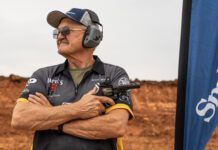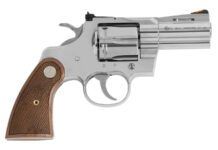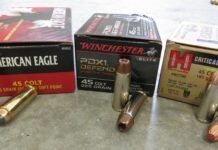As much as some may think the revolver’s sun has set, we see the platform being reinvented and reconfigured for today’s shooter and everyday carry (EDC). For those who like the simplicity of a double-action wheelgun — at contact distances, they’ve always been durable point-and-shoot choices — we chose three six-shot 357 Magnum revolvers that are newly manufactured and in a reasonable price range of $504 to $894.
The Smith & Wesson Model 66 Combat Magnum comes from an iconic line of Model 66 revolvers. We tested a Model 66-8 variant and found a lot to like about this newest version. There were also a few things we didn’t like. Remember, with a 66-8 you are investing in a pedigree, and there is a cost to access that lineage.
Next, we tested a Ruger GP100 Model 1790, this particular one being a Talo Exclusive, and we think Ruger and Talo did a great job of trying to make a compact revolver out of Ruger’s medium-size GP100 revolver. The Ruger is chunky, but that just means there is more to love, right?
Our third handgun was Rock Island Armory AL3.1 3520S. The Rock Island (RIA) is a relatively new revolver imported from and built in the Czech Republic. We tested a blued AL3.0 a few issues back and gave it a solid A- rating, so here we wanted to handle and shoot a stainless revolver to see how it fared. Could it be a good choice for those wanting to get into a 357 revolver, but who are on a strict budget? Out of the box, we could see it was not as eye appealing as the S&W and Ruger, but we’ll take performance over looks any day.
The common elements of these powerful revolvers are first and foremost the frame size; all are more or less medium-size frames. All have a six-round capacities, 2-inch to 2.75-inch barrels, rubber stocks, double-action/single-action triggers, and plenty of recoil with stiff 357 Magnum loads like the Federal Hydra-Shok self-defense round we used. They also have good accuracy off the bench. The Rock Island has a fixed-groove rear sight, and the Smith & Wesson and Ruger/Talo have adjustable rear sights. The Ruger revolver was more traditional with an all-steel barrel. The S&W and RIA both use more-modern manufacturing approaches with two-piece barrels.
How We Tested
Before actual range testing, we dry-fired these revolvers in double-action trigger mode to accustom ourselves to the trigger pulls. Double-action trigger-pull weights ranged from 11.5 to a very heavy 15 pounds. A heavy trigger-pull weight makes shooting these revolvers more difficult. We thought the Model 66’s trigger was way too heavy, the RIA trigger was okay, and the Ruger trigger was exceptionally smooth and slick. We did not have any issues short-stroking these triggers. These guns were factory new, but we still went through our pre-range testing of the cylinder gap with a feeler gauge and used our range rod match kit ($130; Brownells.com) to check barrel and chamber alignment. All the guns were in spec for cylinder gap, the space from the forcing cone to the front of the cylinder. This dimension should be from 0.004 to 0.010 inch.
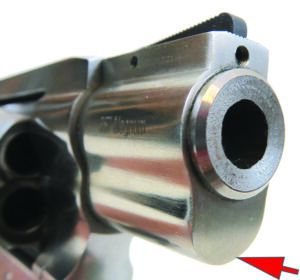
On the range, we tested for accuracy using our range bag as a rest and fired in single-action trigger mode with targets set at 15 yards. We used Thompson Trouble Shooter Target ($6 for five targets from ThompsonTarget.com) with 4- and 6-inch red and bright yellow bullseyes. These targets have a legend at the bottom that shows bullet holes clustered in different areas around the bullseye — left of bullseye, right of bullseye, top of bullseye, etc. — that provides an explanation of why you are not hitting the center. Could be jerking the trigger, anticipating recoil, etc. We have a few “lazy-finger” shooters who push the trigger slightly to the side, rather than pull straight back. Right-hand shooters with lazy fingers will push hits to the left, and left-hand shooters with this affliction will push shots right of center.
The 357 Magnum revolver is as much practical and versatile as it is effective. These revolvers are compatible with both 38 Special and 357 Magnum cartridges. Starting at the mild end, we ran Armscor 38 Special ammo loaded with a 158-grain FMJ bullet. For 357 Magnum ammo, we used Aguila ammunition loaded with a 158-grain JSP and Federal Premium Hydra-Shoks loaded with a 158-grain JHP bullet. The 158-grain bullet is a sweet spot and original load for the 357 Magnum. This bullet weight is also very common for 38 Special and 38 Special +P loads. We also noted that the 38 Special loads printed higher on the target when using the same aim point as 357 Mag ammo. This is due to bullet speed and muzzle flip.
For speed shooting, we moved to 10 yards and fired at 8-inch paper plates in double-action mode as fast as we could while still being accurate. This exercise pushes you to that point where too much speed with the trigger can cause a miss on the target. We can safely say Jerry Miculek is still the speed king with a wheelgun. If you want to train for speed with a revolver, we suggest using 38 Special cowboy loads or reduced-velocity loads so you can practice technique. Going full speed with Hydra-Shoks, we felt as if we grabbed the tail of a rattlesnake. Not exactly fun, and the more we pushed, the worse it was.
For speedloaders, we used Tuff Products six-round QuickStrip speed loaders ($9.45 for two strips from TuffProducts.com), which are a flexible urethane material that allows you to load two rounds at a time, and it lays flat in your pocket. These are what we use for EDC. For holsters, we used a nylon Uncle Mike’s Inside the Waistband (IWB) holster and a Galco leather Phoenix belt holster. Here’s what we found:
Gun Tests Grade: B+ (BEST BUY)
$504
Our expectations were high for the Czech-made AL3.1, having tested the AL3.0 in the May 2020 issue. The matte-stainless finish was okay. We did notice polishing marks on the side plate, but the fit was good. The cylinder locked up tightly, with only a bit of wiggle. The AL3.1 uses a transfer-bar safety system, meaning the trigger must be fully rearward for the hammer to hit the transfer bar and then the firing pin, which is mounted in the frame.
| Action Type | Revolver |
| Trigger | DA/SA |
| Overall Length | 6.75 in. |
| Barrel Length | 2.0 in. |
| Sight Radius | 3.9 in. |
| Overall Height | 4.0 in. |
| Maximum Width | 1.5 in. |
| Weight Unloaded | 32.1 oz. |
| Weight Loaded | 35.6 oz. |
| Cylinder Gap | .004 in. |
| Capacity | 6 |
| Frame and Cylinder | Matte Stainless |
| Barrel Shroud and Sleeve | Matte Stainless |
| Frame Front Strap Height | 2.3 in. |
| Frame Back Strap Height | 3.3 in. |
| Grip | Rubber, textured finger grooves |
| Grip Thickness (max) | 1.2 in. |
| Grip Circumference (max) | 5.1 in. |
| Front Sight | Serrated ramp, removable |
| Rear Sight | Fixed topstrap notch |
| Trigger Pull Weight (DA) | 11.5 lbs. |
| Trigger Pull Weight (SA) | 4.0 lbs. |
| Trigger Span (DA) | 3.3 in. |
| Trigger Span (SA) | 2.9 in. |
| Safety | Transfer bar |
| Warranty | Limited lifetime |
| Telephone | (775) 537-1444 |
| Website | Armscor.com |
| Made In | Czech Republic (imported by RIA) |
The 2-inch barrel is made of two pieces, a steel exterior tube and a steel sleeve. The S&W’s barrel is built in a similar fashion. The barrel has a slight crown. It features a full lug and enclosed the ejector rod. The ejector rod is short, so you need to point the muzzle skyward to assist unloading. The edge of the lug is sharp and catches when holstering. We would knock the edge off for easier holstering.
The front ramp sight is black and serrated, and it is pinned in place. The serrations cut sun glare, which we appreciated. The rear sight is a groove machined into the top strap.
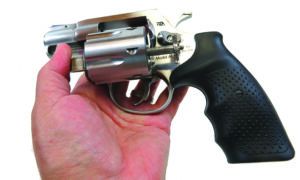
Also similar to the S&W is the RIA’s cylinder latch. Push the latch forward to swing out the cylinder. The latch is serrated for a good grip, with a lip that provided leverage when pushing it forward. The crane on the RIA mates to the front side of the cylinder window, just like a Ruger LCR/LCRx. This set up locks the front on the cylinder while the pin in the ejector locks into the recoil shield. The ejector is unique; it uses six pegs for cylinder rotation in lieu of the traditional spiral star on the Ruger and S&W. During single-action cocking or the double-action trigger pull, the hand pushes up under the peg to rotate the cylinder. No doubt this design feature offers a manufacturing cost savings. The cylinder rotates counter clockwise, and the chambers are countersunk. The machine work was good. We did note the recoil plate is nearly to the outer edge of the cylinder, which made it difficult to see if a chamber has a case in it or if it is loaded.
The trigger was wide and finely serrated, while the hammer spur was also wide and offered plenty of serration for thumbing back the hammer.
The accuracy of the AL3.1 was good. Our best five-shot group measured 1.55 inches with the mild Armscor 38 Special ammo loaded with a 158-grain FMJ. With the 357 Magnum Aguila and Federal Hydra-Shoks, best groups measured 2.02 and 2.25 inches, respectively. The AL3.1 is hefty, and the large rubber grip helps to reduce felt recoil. For speed shooting, the RIA allowed us to stay on target and manage recoil, and we did grip the gun higher to reduce the height of the bore axis. There was some stacking with the RIA, but overall, the trigger pull was fairly smooth and consistent. The double-action trigger pull was 11.5 pounds, and it felt like more. We would have liked a lighter double-action pull. Single-action pull required only 4 pounds, and that was more conducive to accurate shooting. The ejector rod is not long enough to fully eject empties, so tilt the muzzle upward to assist unloading.
From a EDC point of view, the AL3.1 takes more effort to conceal than the others. The rubber grip, though helpful with recoil management, is harder to hide. Upside: Cover garments did not get hung up on the grip.
Our Team Said: We like the weight and full grip of the AL3.1, especially with hot magnum loads. Accuracy was good. Since the weight and full grip make it harder to carry the gun concealed, we would use this as a vehicle gun or in our bedstand. Though good, our shooters said the RIA is not in the same league as the S&W and Ruger, and our rating reflects that conclusion.
38 Special/357 Magnum Range Data
To collect accuracy data, we fired five-shot groups from a bench using a rest. Distance: 15 yards with open sights. We recorded velocities using a ProChrono digital chronograph set 10 feet from the muzzle.| Armscor 38 Special 158-grain Full Metal Jacket | Smith & Wesson Model 66-8 | Ruger/Talo GP100 | Rock Island Armory AL3.1 |
| Average Velocity | 803 fps | 807 fps | 799 fps |
| Muzzle Energy | 226 ft.-lbs. | 228 ft.-lbs. | 224 ft.-lbs. |
| Smallest Group | 1.45 in. | 2.81 in. | 1.55 in. |
| Average Group | 1.81 in. | 2.85 in. | 1.97 in. |
| Aguila 357 Magnum 158-grain Semi-Jacketed Soft Point | Smith & Wesson Model 66-8 | Ruger/Talo GP100 | Rock Island Armory AL3.1 |
| Average Velocity | 1097 fps | 1115 fps | 1000 fps |
| Muzzle Energy | 422 ft.-lbs. | 436 ft.-lbs. | 351 ft.-lbs. |
| Smallest Group | 2.64 in. | 2.29 in. | 2.02 in. |
| Average Group | 2.75 in. | 2.63 in. | 2.65 in. |
| Federal Hydra-Shok 357 Magnum 158-grain Jacketed Hollow Point | Smith & Wesson Model 66-8 | Ruger/Talo GP100 | Rock Island Armory AL3.1 |
| Average Velocity | 1112 fps | 1164 fps | 999 fps |
| Muzzle Energy | 434 ft.-lbs. | 475 ft.-lbs. | 350 ft.-lbs. |
| Smallest Group | 1.02 in. | 2.35 in. | 2.25 in. |
| Average Group | 1.83 in. | 2.49 in. | 2.60 in. |
Value Guide: Shorter Revolver Rankings
| Gun Name | Issue | Grade | Comments |
|---|---|---|---|
| S&W Model 60 38 Special, $459 | Dec. 2021 | B+ | Stainless-steel construction throughout. We docked it a grade for the very heavy trigger. |
| Ruger Light Compact Revolver (LCR) 5401 38 Special, $699 | Dec. 2021 | B | A little lighter, with recoil that goes with that. One of the best revolver triggers we have seen. |
| Ruger SP101 5737 38 Special, $859 | Dec. 2021 | B- | Stainless-steel weight mitigates recoil. Too heavy for pocket carry. Okay for home defense. |
| Taurus Tracker 692 38 Sp./357 Mag./9mm Luger, $487 | Oct. 2021 | A | Our Pick. Excellent versatility. Other revolvers do not have this versatility or offer seven shots. |
| Taurus Defender 856 2-85639NS 38 Sp. +P, $306 | Oct. 2021 | A- | Best Buy. Offers six-shot capacity, a 3-inch heavy barrel, and a tritium-insert front-sight. |
| EAA Weihrauch Windicator 741566103612 357 Mag., $394 | Oct. 2021 | A | Need a house gun or truck gun to be fired occasionally, but which must always come up shooting? This is it. |
| Rock Island Armory M206 51283 38 Sp., $240 | Oct. 2021 | B | We disliked the too-long hammer spur, and the wooden concealment grips are not well designed. |
| Taurus 856 Defender Ultra-Lite 2-85639ULNS 38 Sp. +P, $405 | Aug. 2021 | A | Our Pick. Offered good accuracy and is ultra-lightweight. The DA trigger was smooth but heavy, with stacking. |
| Ruger SP101 Model 5784 327 Federal Magnum, $749 | Aug. 2021 | A | This offers excellent accuracy and versatility with the ability to fire multiple 32-caliber cartridges. |
| Charter Arms Professional 73230 32 H&R Magnum, $420 | Aug. 2021 | A- | Offers 7-shot capacity and can fire a variety of 32-cal. cartridges. Light weight, nice fiber-optic front sight. |
| Smith & Wesson Model 351 PD 160228 22 WMR, $766 | Apr. 2021 | A | Our Pick. Offers light weight, 7-shot capacity, and a bright Hi-Viz fiber-optic front sight that we really liked. |
| Ruger Model LCRx 5439 22 WMR, $599 | Apr. 2021 | A- | Light weight, great grip, good accuracy. DA trigger pull was very heavy. Would have liked more capacity. |
| Taurus Model 942 2-942M029 22 WMR, $309 | Apr. 2021 | B | Eight-shot capacity. Heavy, so concealability in a pants pocket is not practical. Trigger pull was heavy. |
| Smith & Wesson PC Model 986 10227 9mm Luger, $1129 | Mar. 2021 | A | Our Pick. All-business, made-to-perform revolver. Offered excellent accuracy with Hornady Critical Duty ammo. |
| Rock Island Armory AL9.0 9231B 9mm Luger, $599 | Mar. 2021 | A | Offered good accuracy and shooting comfort due to the full-size grip. Aesthetics are not its strong point. |
| Taurus Tracker 692 2-692039 9mm/38 Sp./357 Mag., $705 | Mar. 2021 | A- | Offers a lot of versatility with the extra cylinder assembly. The price is reasonable. |
| Colt King Cobra KCOBRA-SB3BB 357 Magnum, $838 | May. 2020 | A | Our Pick. A 357 Magnum powerhouse. Offers good performance with the 3-inch barrel and is well made. |
| Rock Island Armory AL3.0 357 Magnum, $504 | May. 2020 | A- | Best Buy. Good price, accuracy, shooting comfort. Not a beautiful revolver, but it did provide performance. |
| Rossi Model 971 VRC 357 Magnum, $295 | May. 2020 | B | Great trigger, and the porting helped keep us on target. Accuracy was less than stellar. |
| Ruger LCRx 5435 22 LR, $470 | Apr. 2020 | B+ | The LCRx is lightweight and would make a nice kit gun if that were the only consideration. Cost is too high. |
| Smith & Wesson Model 637-2 163050 38 Special +P, $389 | Dec. 2018 | A | Our Pick. Consistent trigger pull, DA or SA trigger mode, recoil absorbing grip, and lightweight. |
| Taurus 856 Model 2-856021 38 Special, $278 | Dec. 2018 | A- | Consistent trigger in double-action or single-action mode, a small grip, and it offers six shots. |

























